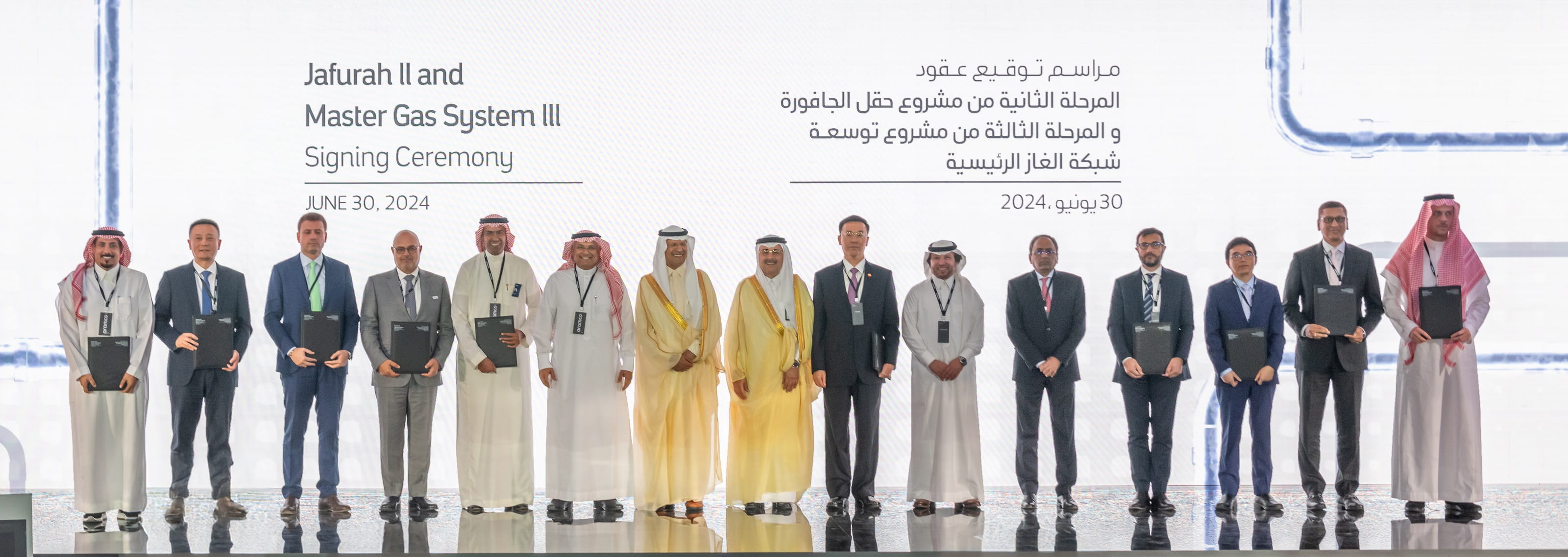아람코의 가스 확장 전략, 250달러 규모의 계약 체결 통해 진전

지난 6월 30일 사우디아라비아 다란에서 열린 아람코의 마스터 가스 시스템 III 계약 체결식
- 담대한 자푸라 가스 개발 2단계 사업, 약 124억 달러 규모 계약 체결
- 아람코 마스터 가스 시스템 3단계 확장 위한 약 88억 달러 규모 계약 체결
- 2022년 12월부터 2024년 5월까지 24억 달러 상당의 비전통 가스 시추 장비 23건, 6억 1,200만 달러 상당의 방향 시추 계약 2건, 16억 3,000만 달러 상당의 자푸라 유정 연계 계약 13건 체결
- 해당 프로젝트들은 아람코의 가스 생산 성장을 지원하고 포트폴리오를 다각화하며 상당량의 에탄, NGL 및 콘덴세이트 추가 생산을 목표
글로벌 종합 에너지∙화학 기업 아람코가 2030년까지 판매 가스 생산량을 2021년 대비 60% 이상 늘리는 것을 목표로 하는 가스 확장 전략을 위해 250억 달러 규모 이상의 계약들을 체결했다고 밝혔다.
이 계약들은 방대한 자푸라 비전통 가스전의 2단계 개발, 아람코의 마스터 가스 시스템 3단계 확장, 신규 가스 리그 및 지속적인 용량 유지 보수를 골자로 한다.
아민 H. 나세르 아람코 대표이사 사장은 “이번 계약 체결은 중요한 에너지원이자 다운스트림 산업의 필수 공급원료인 가스의 미래에 대한 우리의 확고한 믿음을 보여준다. 자푸라에 대한 지속적인 투자 규모와 마스터 가스 시스템의 확장은 예상되는 수요 증가 충족을 위해 가스 사업을 통합하고 성장시키려는 우리의 의지를 강조하는 것이기도 하다. 또한, 당사의 포트폴리오 다각화를 보완하고 새로운 고용 기회를 창출하며 가스와 신재생 에너지가 점진적으로 액체 기반 발전을 대체하는 저배출 전력망으로의 전환을 지향하는 사우디아라비아의 노력을 지원한다. 오늘날의 위치에 이르기까지 아람코의 방대한 공급 업체 및 서비스 제공 업체 네트워크는 큰 노력과 혁신, 그리고 강한 ‘할 수 있다’의 정신으로 세계적 수준의 에너지 인프라를 구축하고 확장하려는 아람코의 여정에 함께 해왔다.”고 밝혔다.
계약 수주 현황
당사는 자푸라 2단계 개발을 위해 총 124억 달러 규모에 달하는 16건의 계약을 체결했으며 가스 압축 시설, 관련 파이프라인 및 가스 처리 트레인 건설을 포함한 자푸라 가스 플랜트 확장, 유틸리티, 유황 및 수출 시설 건설이 포함된다. 또한, 자푸라에서 공급받는 NGL 처리를 위해 주베일에 새로운 리야스 천연가스액체 배분시설 – 천연가스배분 트레인, 유틸리티, 저장 및 수출 시설을 건설하는 공사도 진행할 예정이다.
사우디아라비아 전역에 걸친 고객에게 천연가스를 공급하려는 마스터 가스 시스템의 3단계에 걸친 확장을 시작하기 위해 약 88억 달러에 달하는 15건의 일괄수주계약도 체결되었다. 사우디 에너지부와 협력하여 진행되는 이 확장 공사는 약 4,000km의 파이프라인과 17개의 새로운 가스 압축 트레인 설치를 통해 2028년까지 네트워크 규모를 늘리고 총용량을 31억 5,000만 scfd까지 늘릴 계획이다.
또한 24억 달러 규모의 가스 리그 23기와 6억 1,200만 달러 규모의 방향 시추 계약 2건도 추가로 체결되었다. 한편, 2022년 12월부터 2024년 5월까지 자푸라에서는 총 16억 3,000만 달러 상당의 13건의 유정 연계 계약이 체결되었다.
자푸라의 진행 상황
자푸라 비전통 가스전에는 229조 scf의 처리 가스와 750억 STB(Stock Tank Barrels)의 콘덴세이트가 매장된 것으로 추정된다. 2021년 1월에 시작된 자푸라 개발 프로그램의 1단계는 예정대로 진행되고 있으며, 2025년 3분기에 초기 가동이 시작될 것으로 예상된다. 아람코는 자푸라에 대한 전체 수명 주기 투자 총액이 1,000달러를 넘어설 것으로 예상하며, 2030년까지 막대한 양의 에탄, 천연가스 액체 및 콘덴세이트뿐만 아니라 20억 scfd 규모의 지속 가능한 가스 판매량 달성을 계획 중이다.
마스터가스 시스템 확장
아람코의 마스터 가스 시스템은 사우디아라비아 전역의 아람코 주요 가스 생산 및 처리 현장을 연결하는 광범위한 파이프라인 네트워크이다. 이 네트워크의 확장은 산업, 유틸리티 및 기타 부문의 고객에게 국내 가스 공급에 대한 접근성을 높여 발전용 석유 대신 온실가스 배출이 적은 대안을 제공할 것으로 기대된다. 또한 이 네트워크는 1982년부터 석유 생산 과정에서 배출되는 ‘폐가스’로 불리는 관련 가스를 플레어화 하지 않고 운송해 왔는데, 이는 아람코의 혁신과 배출량 완화에 도움이 되는 솔루션의 선도적인 채택을 보여주는 사례이기도 하다. 현재 관련 가스와 판매용 가스를 운송하는 이 선구적인 네트워크는 아람코가 2012년부터 넷제로 가스 플레어링 및 전체 원료 가스 생산량의 1% 미만의 플레어 양을 유지하는데 기여하여 업계에서 가장 낮은 업스트림 탄소 집약도를 달성하는 데 큰 역할을 담당했다.
